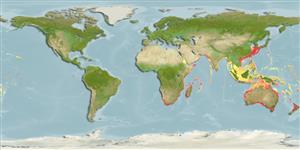Preferred temperature (Ref.
115969): 13.3 - 25, mean 19.3 (based on 186 cells).
Phylogenetic diversity index (Ref.
82804): PD
50 = 0.5010 [Uniqueness, from 0.5 = low to 2.0 = high].
Bayesian length-weight: a=0.00776 (0.00405 - 0.01487), b=3.07 (2.90 - 3.24), in cm Total Length, based on LWR estimates for this species & (Sub)family-body (Ref.
93245).
Nivel trófico (Ref.
69278): 3.7 ±0.57 se; based on food items.
Resiliencia (Ref.
120179): Medio, población duplicada en un tiempo mínimo de 1.4-4.4 años (K=0.4-0.6; tm=2-3; tmax=15;).
Prior r = 0.36, 95% CL = 0.24 - 0.55, Based on 1 data-limited stock assessment.
Fishing Vulnerability (Ref.
59153): Low to moderate vulnerability (29 of 100).
Climate Vulnerability (Ref.
125649): Moderate to high vulnerability (45 of 100).
